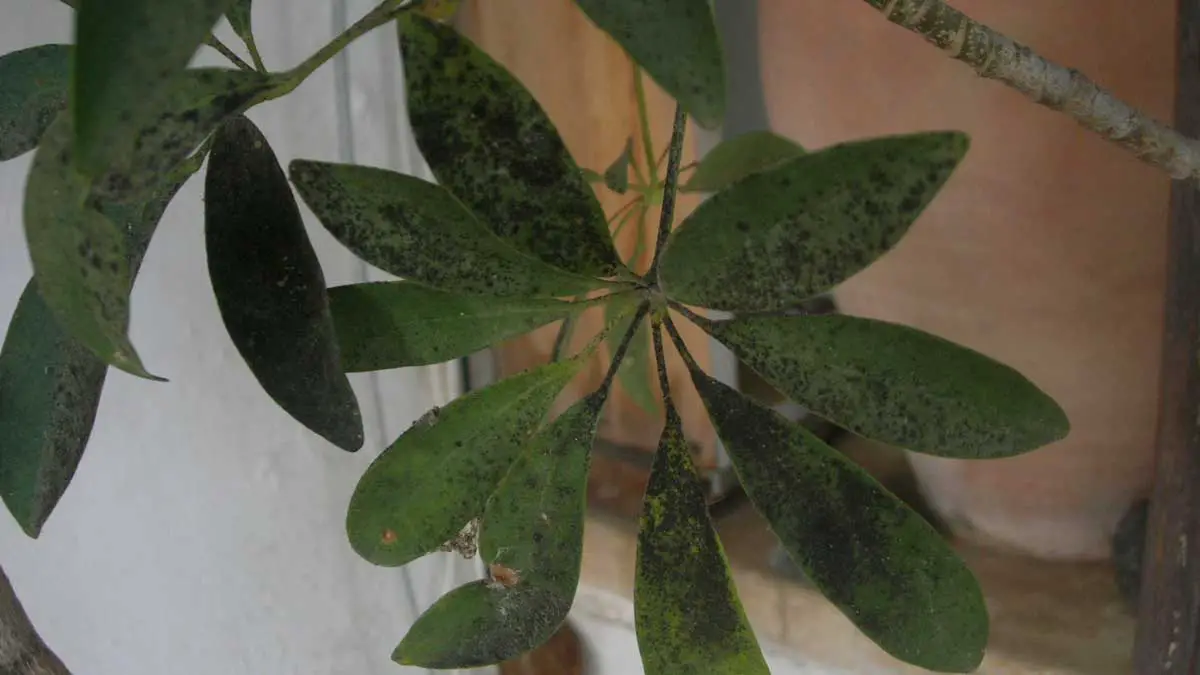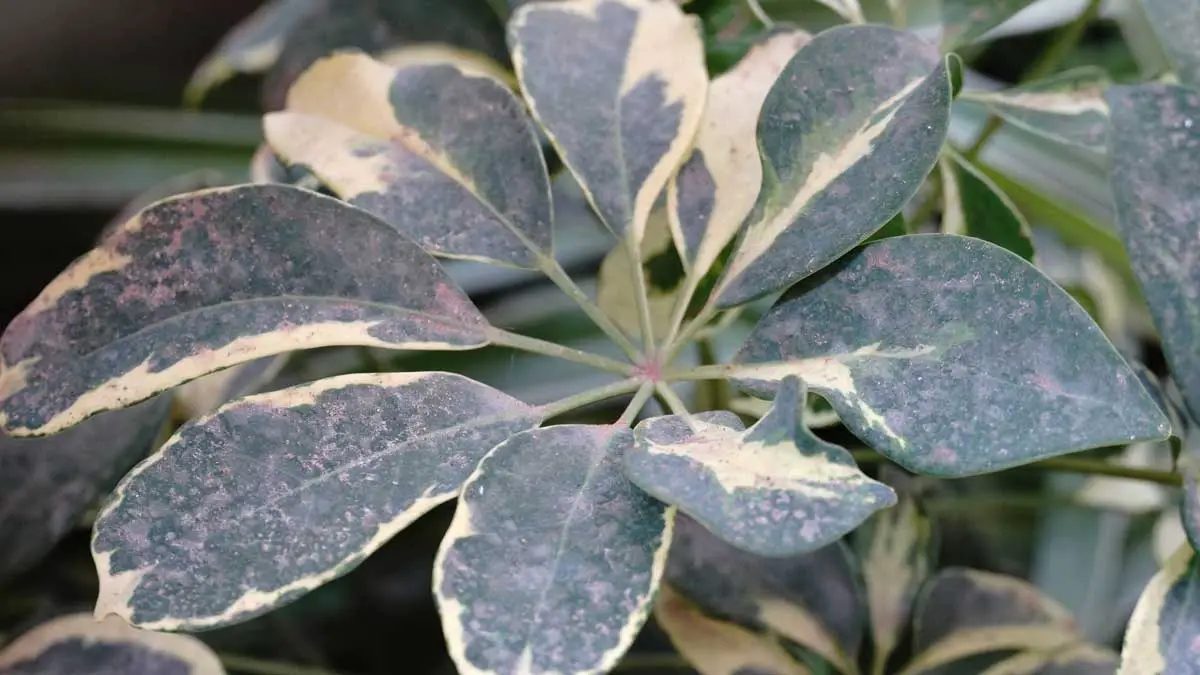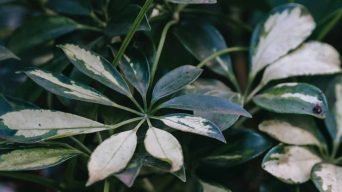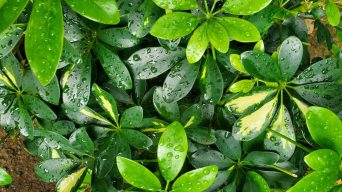Schefflera, commonly known as the umbrella plant or the umbrella tree, are attractive, tough, and easy to grow.
They can be used as houseplants or in outdoor gardens in warm climates. Some varieties of Schefflera can grow to be large trees.
Schefflera leaves are usually a deep green color, but if the leaves start turning black, it is a sign that something is wrong with the plant.
Why Are My Schefflera Leaves Turning Black and How Can I Fix It?
There are several possible causes for black leaves on a Schefflera.
Here are some common causes of black leaves on Schefflera plants and what you can do to fix the problem.
1. Overwatering
Overwatering is one of the most common reasons for black leaves on Schefflera plants.
If you notice the leaves turning black and falling off, you are likely watering the plant too often.
Scheffleras are tough plants and can withstand periods of drought, but they will not tolerate being waterlogged.
If you water your Schefflera too often, the roots will not get the oxygen they need to function correctly. This can cause the leaves to turn black and eventually die.
You can tell if your Schefflera is overwatered, the leaves are wilting, or the stem is soft.
How To Fix It
If you think you are overwatering your Schefflera, the best solution is to let the plant dry out completely.
Do not water the plant until the soil is completely dry. Once the soil is dry, water the plant deeply and let it dry out again before watering it again.
It is also a good idea to check the drainage of your pot. If the pot does not have proper drainage, the roots will sit in water, and this can cause the leaves to turn black.
2. Underwatering
One of the most common reasons for Schefflera leaves to turn black is underwatering.
Schefflera plants are very sensitive to drought and will experience leaf stress when they do not receive enough water.
If your plant is not getting enough water, the leaves will start to droop and turn yellow or brown.
Eventually, they will turn black and fall off.
You can tell if your Schefflera needs water if the leaves start to droop or the soil is dry to the touch.
How To Fix It
If your Schefflera is not getting enough water, you need to increase the watering frequency.
Water the plant until the soil is evenly moist, and ensure the pot has drainage holes so the excess water can drain out.
Schefflera plants need to be watered every week or two, but the frequency will depend on the size of the pot and the type of potting soil mix.
If you are unsure how often to water your plant, check the soil before watering to see if it is dry.
3. Temperature Stress
Another common cause of black leaves on Schefflera plants is temperature stress.
Schefflera plants are native to tropical climates and prefer warm temperatures.
If the temperature drops too low, the leaves will start to turn black.
You can tell if this is the cause of the black leaves if the leaves are only black on the tips or edges.
How To Fix It
If your Schefflera is experiencing temperature stress, moving it to a warmer location is best.
Schefflera plants should be kept in temperatures between 65 and 90 degrees Fahrenheit.
If the temperature drops below 60 degrees Fahrenheit, the plant will start to experience stress.
4. Fertilizer Issues
Another potential reason for your Schefflera’s leaves turning black could be fertilizer-related issues.
Schefflera plants are not heavy feeders, and too much fertilizer can cause more harm than good.
If you’re fertilizing your plant with too much fertilizer, or if the fertilizer you’re using is high in nitrogen, this can cause the leaves of your Schefflera to turn black.
You can tell if your Schefflera is getting too much fertilizer if the leaves are turning black, and there is also fertilizer build-up on the top of the soil.
How To Fix It
If you think your Schefflera is getting too much fertilizer, you first should flush the soil with water to remove any excess fertilizer.
After flushing the soil, cut back on how often you fertilize your plant and make sure to use a fertilizer that has a lower nitrogen content.
They must only be fertilized every month or two during the growing season.
Use a balanced fertilizer, such as 10-10-10, applied at half the recommended rate.
5. Pest Infestation
Another reason your Schefflera’s leaves may turn black is a pest infestation.
Schefflera plants are susceptible to various pests, including aphids, spider mites, and mealybugs.
These pests can cause your plant’s leaves to turn black or brown as they suck the nutrients and moisture from the leaves.
You can tell if your Schefflera has a pest infestation if you see small insects on the leaves or stems or if there is a sticky substance on the leaves.
How To Fix It
If you have a small infestation, you can remove the pests by hand using a cotton swab dipped in rubbing alcohol.
You may need to use insecticidal soap or neem oil for a more severe infestation.
Make sure to follow the directions on the product label.
You should also try to keep your plant healthy and stress-free, making it less susceptible to pests.
6. Mineral Build-Up
Another possible reason for black leaves on Schefflera plants is due to a mineral build-up in the soil.
Over time, the minerals in the water you use to water your plant can build up in the soil and cause toxicity issues.
This is more common if you have hard water or if you live in an area with high mineral content in the water.
Tap water typically has high mineral content.
You can tell if your Schefflera has a mineral build-up if the leaves are turning black and there is also a yellow or white substance on the leaves.
How To Fix It
If you think your Schefflera has a mineral build-up, the best solution is to flush the soil with water.
You can do this by thoroughly watering your plant and then allowing the water to drain completely.
Do this once a month, and use distilled or filtered water for your plant.
7. Too Much Sunlight
While Schefflera plants need some sunlight to thrive, too much sunlight can cause the leaves to turn black.
Schefflera plants should be kept in bright indirect light.
The leaves can get sunburned and turn black if kept in direct sunlight.
You can tell if your Schefflera is getting too much sunlight if the leaves are turning pale green or yellow in addition to black.
They also may be drying out or developing brown spots.
How To Fix It
If you think your Schefflera is getting too much sunlight, the best solution is to move it to a location with less direct sunlight.
An east- or west-facing window is typically a good option.
This will allow the plant to get sunlight without being in direct sunlight for too long.
You can also try to filter the sunlight using a sheer curtain or blind.
8. Too Much Shade
While Schefflera plants need some sunlight to thrive, too much shade can cause the leaves to turn black.
Schefflera plants that are kept in too much shade will often develop long stems as they try to reach for the light.
The leaves may also turn black or brown as they try to get more light.
You can tell if your Schefflera is getting too much shade if the leaves are turning black or brown and the stems are long and leggy.
How To Fix It
If you think your Schefflera is getting too much shade, the best solution is to move it to a location with more light.
They need at least 4 hours of indirect sunlight each day, so a location near a window would be ideal.
You can also try using a grow light to give your Schefflera the extra light it needs.
9. Fungal Disease

Fungal diseases can also cause the leaves of your Schefflera to turn black.
Sooty mold is one of the most common fungal diseases affecting Schefflera plants.
Sooty mold is a black fungus that grows on the leaves and stems of plants.
It is usually caused by pests, such as aphids or mealybugs, that secrete a sticky substance called honeydew.
The honeydew provides the perfect environment for the sooty mold to grow.
You can tell if your Schefflera plant has sooty mold if there is a black substance on the leaves or stems.
The leaves may also be discolored or stunted in growth.
How To Fix It
If you think your Schefflera has sooty mold, the best solution is to remove the pests causing it.
You can do this by spraying your plant with water or by using insecticidal soap.
Once the pests are gone, the sooty mold will start to disappear on its own.
You can also remove it manually by wiping it off with a damp cloth.
10. Root Rot
Root rot is another common disease that can cause the leaves of your Schefflera to turn black.
Root rot is caused by a fungus attacking the plant’s roots.
The fungus can enter the plant through the soil or through wounds in the roots.
Once the fungus has infected the roots, it will start to kill them.
This will cause the plant leaves to turn black and eventually die.
You can tell if your Schefflera has root rot if the leaves turn black and fall off.
The roots may also be soft and mushy.
How To Fix It
Root rot is a severe problem that can kill your Schefflera plant if it’s not treated quickly.
If you think your Schefflera has root rot, the best solution is to replant it in sterile, fresh soil.
Be sure to remove any affected roots before replanting and as much of the old soil as possible so that you don’t spread the fungus to the new plant.
You can also treat the affected plant with a fungicide to help kill the fungus.
11. Bacterial Disease
Bacterial diseases can also cause the leaves of your Schefflera plant to turn black.
Bacterial Leaf Blight is one of the most common bacterial diseases affecting Schefflera plants.
Bacterial Leaf Blight is caused by a bacterium that attacks the plant leaves.
The first symptom of Bacterial Leaf Blight is small, water-soaked spots on the leaves.
These spots will eventually turn black, and the leaves will die.
You can tell if your Schefflera has Bacterial Leaf Blight if it has small, black spots on the leaves.
How To Fix It
If you think your Schefflera plant has Bacterial Leaf Blight, the best solution is to remove the affected leaves.
You can also treat the plant with a bactericide to help kill the bacteria.
How To Prevent Schefflera Leaves From Turning Black
Schefflera plants are known for their glossy, evergreen leaves and tolerance to a wide range of indoor growing conditions.
However, even the hardiest Schefflera can experience leaf problems from time to time.
One such problem is the blackening of the leaves, which several factors can cause.
The best way to prevent your Schefflera plant from getting black leaves is to provide it with the proper care.
Here are a few tips on how to care for your plant to prevent leaf blackening:
- Make sure the plant is getting enough light. Schefflera needs bright indirect light to thrive. If the leaves are turning black, it may be a sign that the plant is getting too much or too little light.
- Water the plant regularly, but do not overwater. Schefflera likes to have moist soil, but too much water can cause the leaves to turn black. Check the soil before watering; only water when the top inch or two of soil is dry.
- Use distilled or rainwater. Hard water can cause mineral build-up on the leaves, which can lead to blackening.
- Use a well-draining soil. Soil that does not drain well can lead to root rot, which can cause the leaves to turn black.
- Prune the plant as needed. Schefflera can become leggy and overgrown if not pruned regularly. Cut back the stems to encourage new growth and prevent the leaves from turning black.
- Fertilize the plant monthly during the growing season. Use a balanced fertilizer and be sure to follow the directions on the package. Too much fertilizer can cause the leaves to turn black.
- Monitor the temperature and humidity. Schefflera does best in warm, humid conditions. If the air is too dry or too cold, the leaves may turn black.
- Check for pests. Aphids, mealybugs, and spider mites can all cause leaf blackening. Be sure to check your plant regularly for pests and treat them immediately if found.
Following these tips can prevent your Schefflera plant from getting black leaves.
If the leaves turn black, try to identify the cause and take corrective action.
With proper care, your Schefflera will thrive and remain beautiful for years.
Final Thoughts
If your Schefflera leaves are turning black, it is most likely due to one of the following reasons: too much direct sunlight, water stress, overfertilization, or diseases.
In any case, the solution is to improve your plant’s growing conditions.
Make sure to give it the right amount of light and water, and don’t overfertilize it.
If you do all of these things, your Schefflera (Umbrella Plant) should start to look better in no time!







